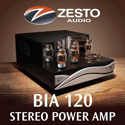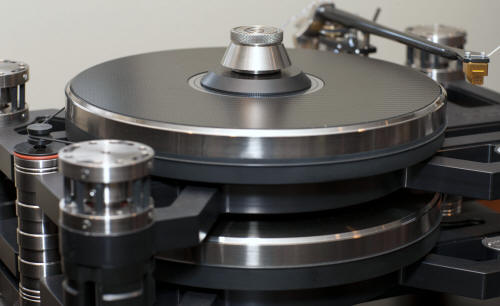|
|
You are reading the older HTML site
Positive
Feedback ISSUE 76
kronos audio products Sparta Turntable as reviewed by Marshall Nack
Watching the Kronos Audio Products Sparta Turntable being assembled on my rack, it's clear that this is not your father's turntable. Visually, the Sparta is unlike any vinyl spinner I've encountered—the same goes for the accompanying Helena tonearm.
Without a doubt, it's that second, counter-rotating platter that catches your eye and wants explaining. Why is it there? What does it do? It is extremely rare and it is the heart of the design. Only one other manufacturer has a two platter turntable, 47 Laboratory, but the Kronos implementation is unique and has been granted a US patent for the combination of a freely hung suspension with counter-rotating platters.
Smearing: the Evil Gremlin Analog playback is bedeviled by engineering problems so numerous a designer can pick and choose among them. For Louis Desjardins, the designer and proprietor of Kronos, smearing caused by uncontrolled vibration is the primary gremlin. Louis lays out the issue in his white paper, "The Limitations of Traditional Turntable Design…" available on the Kronos website: "All turntables currently on the market are constructed either with or without a suspension system. Suspended turntables are better isolated from both mechanical and sound vibrations…. These turntables are often preferred to rigid ones as they deliver a more organic sound and a softer presentation. However, the suspended platter and tone arm present a significant downside—a pronounced blurring of the musical signal. This is caused by torsional forces, a natural tendency of the sub-platter frame to rotate in sync with the platter….[With the suspended design] the slightest vibration coming from the stylus reading the groove is echoed back to the stylus, out of phase. The result: the stereo image produced is blurred and distorted…." Rigid turntables don't fare any better in his estimation: "To solve the problem of torsional forces, some manufacturers build a rigid turntable and completely eliminate the suspension. But vibrations produced naturally by mechanical components and the environment are fed back to the platter and tone arm, causing yet another type of blurring and distortion of the music signal. The resulting sound is often described as harsh, aggressive and glassy." And his solution: "KRONOS… employs two identical, high-mass platters, one above the other rotating in opposite directions and moving at precisely the same speed. This engineering completely eliminates torsional forces. Since the turntable is protected from mechanical and environmental vibrations, it can therefore be suspended without any negative outcomes." That's the theory. Let's see how it performs in the real world. Dynamic Independence The Sparta will not be a shock to anyone used to top flight vinyl playback—at least not with a casual listen. Broadly speaking, it is in line with other Class A analog rigs in terms of overall tone, stage dimensions, orchestral weight and dynamics. However, with longer exposure—for me, it only took a minute, but then I'm attuned to these things—you will see how it pushes all of these boundaries.
For our first LP, let's spin that old chestnut, "Good Morning Heartache" from Clap Hands, Here Comes Charlie! (Verve V6-4053, original pressing). We expect a good analog front-end to place well-formed images upon a stable stage. The best tables take it a step further and imbue the images with life and vitality. They acquire independence of movement. I hear that with my reference Dr. Feickert Firebird fitted with the Reed 3P Tonearm. But I do not ever recall witnessing Ella Fitzgerald as vital as she is now. Her vocal gymnastics run the gamut of the dynamic scale, bouncing up and down from whispers to near shouts, and her voice is in constant motion, transitioning in minute gradations or giant leaps. Transitions are so finely delineated as to appear liquid or seamless, so that you have zero sense of an electro-mechanical process involved. The rhythm section—bass and drums in the right speaker, piano and guitar in the left—provides a stark contrast: the boys in the band are equally well-formed images, but they keep a steady, low-key groove going, while the robust Ella image in the center has all this dynamic energy and is so alive and vibrant. The Sparta doesn't merely hint at them, it recreates both types fully realized. The contrast between these simultaneous events is extreme. With most front-ends, you're lucky if the center image is imbued with this kind of independence. To have this quality granted across the board is rare indeed. It makes the stage seem alive across its span, resulting in a big boost to credibility. Construction of Images and Soundstage You get to peer in and see Ella navigate the song. Her technique is on display, i.e. the mechanics of her vibrato, its velocity and intensity, and to which notes it's applied. It's uncanny to witness the deployment of these skills as she shapes the lyrics to the desired effect. It's like making the switch to HD TV. I would guesstimate there's 15-20% more information on the stage than I'm used to hearing from the Feickert/Reed or other Class A turntables I've heard. Invariably, these other turntables hit a veil and lose focus en route to the finish line and don't allow you to go deeper. A Proof of Concept Test What enables this laser-sharp view into the proceedings on this demonstration-class LP? Remember that white paper, "The Limitations of Traditional Turntable Design"? It is the removal of smearing. When I mentioned the Kronos table in casual conversations with my audio buddies, to a man, they all professed to admire its sound. However, a few were skeptical about the counter-rotating platter. From an engineering or conceptual point of view, these sophisticated audiophiles didn't understand the value of introducing a second platter and suggested it would sound just as good without it. Beyond that, they saw it as an additional maintenance burden, along with the elaborate suspension and plinth.
We came up with an easily performed proof of concept test. Because the lower platter of the Sparta is independently driven, we simply removed the belt from the lower pulley, so that only the top platter was spinning. (You can't do this with the Kronos Limited Edition model.) What did it sound like? A little drum roll, please. The 20/20 acuity backs off, the details get blurry, and it begins to take on the characteristics of the Firebird/Reed. Louis' theory was corroborated in actual listening. I always start my sessions with the Firebird/Reed and the listening panels' response is, "Hey, that's really good analog." And then I move to the Sparta/Helena, and the reaction is, "Yikes! How could there be so much more there?" Noise Reduction It's not just due to the counter-rotating platter. Louis' penultimate target is noise. Noise is ubiquitous; it can be generated by nearly anything and is only eradicated if you hunt down its source and remove it. The Sparta's cloudless, blue sky view hinges on attention to details such as these:
Once again, regarding noise, the Sparta is an iconoclast; it just doesn't seem to be generating any. Tonal Consistency Turntables are often inconsistent in how they reproduce the segments of the frequency spectrum. The Firebird/Reed, for example, is clear and detailed in the mids, almost see-through, while its top-end is smooth and sweet, but bass is a tad soft and large—a variable treatment. The Sparta has a "cut from the same cloth" consistency all the way from bass through treble, and it all has the same cool-grey color cast. It all moves together, integrated and coherent—the treble doesn't detach from the upper mids and the bass doesn't come from an isolated spot in the lower right corner. This is why Ella's high notes can run free-range and not bite you; this is why her transitions are seamless. Let's Not Forget About Musicality The Sparta does not add schmaltz or other beauty products: there is not a drop of romance in its presentation. It is as accurate as I've heard. But all of this would be for naught if it came in a lean and mean, analytical package. As I've stated many a time, extreme insight packaged in an unmusical presentation is a devil's bargain I'd never condone. Not to worry. The Sparta brings generous musical qualities to bear. As my panel-mate George, a traditional analog guy highly sensitive to these things, put it, the Sparta is "…more emphatic, more rich, more present; more the good." Right-o, George. (I even got his syntax right.) Body is generously (and consistently) allocated from bass through treble and image size grows: yet nothing is loose, there is no fat anywhere. And this table can sure heave a lot of low-end weight around when needed.
The illusion of soundstage dimension—positioning instruments in receding, well-defined, rows upon the stage—is something at which super tables are adept. The Sparta builds upon this and imbues images with fine 3-D modeling, promoting the impression of roundness. Looking back over my notes, I'm struck by how often I resorted to visual metaphors in describing the soundstage. This is all quite the opposite of dancing, skeletal images. the Helena Tonearm Kronos has taken on global distribution for tonearms manufactured by André Thériault. The supplied 10.5" Helena Tonearm is designed specifically for the Sparta. (The Kronos Limited Edition table has its own dedicated arm, the 12" Black Beauty model.)
The Helena is unlike any unipivot tonearm I've seen. Principle features include:
System The Helena tonearm was fitted with an Air Tight PC1s, a medium output MC cartridge that has proven compatible with every arm I've tried. It is my reference on the Feickert/Reed. Phono stages used were the Vitus SP-102 and Allnic H-3000V, in turn feeding the Trinity Preamp. Amplification was aptly served by the Audionet MAX Monoblocks.
The whole was wired soup to nuts with Kubala-Sosna Elation!, including the newly released XPander Power Distributor. Installation The Sparta has a fairly large footprint, 20" W x 14" D x 11" H, and weighs 70 lbs. Assembly is a long, involved process—not difficult, just lengthy—due to the many pieces in the elaborate plinth structure. Fit and finish of materials is first rate. This is a serious machine, and its design and materials promote confidence. Most often turntables are suspended from below the platter. The Sparta is suspended from above, with both platters freely hung from rubber ‘O' rings in the four corner towers. This hanging plinth design directly impacts the quality of the bass. Suspended tables typically have soft, mushy bass—not the case with the Sparta. Bass is tight and fast, as fast as any non-suspended turntable.
One thing to note: because it is suspended, you should not use any third-party isolation product with levelling features. I normally put turntables on a Vibraplane ELpF active air suspension, so the ELpF was moved to another shelf. Conclusion A cloudless day has dawned over the vinyl landscape, one where you feel you can see forever and your view is only limited by your acuity. There are no environmental impediments in the way. Translated into audio-lingua, what that poetic prose means is the Kronos Audio Products Sparta Turntable goes very far towards neutralizing uncontrolled vibrations, a major cause of cloudy, overcast conditions. The Kronos Sparta's counterintuitive design is a serious assault on one of analogs principal gremlins—smearing. Control and focus run deep, allowing unprecedented resolution. But it is also maximally musical. You can have it all with the Sparta: the must-have Audio Check List items as well as equally strong performance on the subjective/musical criteria. So many listeners asked me, "Why would you want to look further? This is the one." A call to arms is mandated: If you're in the market for a turntable above the $20K price point, you really should check out the Kronos line up before making a decision. Marshall Nack
Sparta
Turntable
Helena
Tonearm
Kronos
Audio Products Distributor Information
GTT Audio/Video |












